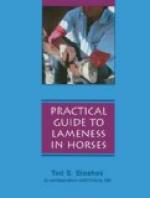Luxation of the patella is a condition wherein the articular portions of the femur and patella assume abnormal relations whether such displacement of the patella be momentary and capable of spontaneous reduction, or fixed and requiring corrective manipulation. Spasmodic contraction of the crural muscles which sometimes retains the patella in such position that the leg is rigidly extended, does not in itself constitute luxation of the patella; and unless this bone becomes lodged on the upper portion of a femoral condyle or laterally displaced out of its femoral groove, luxation cannot be said to exist in the horse. These are sub-luxations.
Occasionally one may observe in suckling colts outward luxation of the patella wherein there is history of navel infection and no marked evidence of rachitis is present. Some of these cases recover. In a unilateral involvement of this kind in a three-month-old mule colt, the author observed a case wherein an unfavorable prognosis was given and destruction of the subject advised, because of the extreme dislocation of the patella. This colt, however, was not destroyed and in three weeks had apparently recovered. No treatment was given in this instance; the colt was allowed the run of a small pasture with its dam and in time it matured, becoming a sound and serviceable animal.
Classification.—Two forms of true patellar luxation in the horse may be considered; one which is due to the patella becoming fixed upon the internal trochlear rim of the femur and the other when the patella slips over the outer rim of the trochlea.
The first form is known as upward luxation and is made possible by rupture of the mesial (internal) femeropatellar ligament. According to Cadiot and Almy, it is only by the rupture of this ligament—the femeropatellar—that upward luxation may occur. This type of luxation is rarely observed and is usually due to violent strain and abnormal extension of the stifle joint.
The second class, outward luxation, occurs in colts and is, in many instances, congenital. This form of luxation is also the one usually seen following debilitating diseases such as influenza and pneumonia.
Upward luxation of the patella is characterized by the stiff-extended position of the leg. When the patella is situated upon the inner trochlear rim, the tibia must be extended because of the traction exerted by the straight ligaments. Since the stifle and hock joints extend and flex in unison, there is presented also an extension of the tarsus. Extension of the stifle joint would increase the distance between the femoral origin of the gastrocnemius and its insertion to the summit of fibular tarsal bone (calcis) were it not for the gastrocnemius and superficial flexor (perforatus). Extension of the hock in upward luxation of the patella, permits of flexion of the phalanges. In upward luxation, then, the leg is extended as if too long, but the phalanges may be in a state of moderate flexion. If the foot rests on the ground when the extremity is not flexed, it is almost impossible for the subject to step backward. Because of immobilization of the stifle and hock joints in upward luxation, the subject can walk only by hopping on the sound leg and then the extremity is flexed, allowing the anterior portion of the fetlock to drag on the ground.




